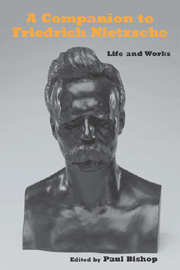Book contents
- Frontmatter
- Contents
- Acknowledgments
- A Note on Editions and Abbreviations
- Introduction
- Link to Nietzsche's Early Writings
- Link to The Birth of Tragedy
- Link to Untimely Meditations
- Link to Human, All Too Human
- Link to Daybreak
- Link to The Gay Science
- Link to Zarathustra
- Link to Beyond Good and Evil
- Link to On the Genealogy of Morals
- Link to The Case of Wagner and Nietzsche contra Wagner
- Link to Twilight of the Idols, The Anti-Christ, and Ecce Homo
- Link to the Nachlass
- Conclusion
- Notes on the Contributors
- Index
Link to The Gay Science
Published online by Cambridge University Press: 05 February 2013
- Frontmatter
- Contents
- Acknowledgments
- A Note on Editions and Abbreviations
- Introduction
- Link to Nietzsche's Early Writings
- Link to The Birth of Tragedy
- Link to Untimely Meditations
- Link to Human, All Too Human
- Link to Daybreak
- Link to The Gay Science
- Link to Zarathustra
- Link to Beyond Good and Evil
- Link to On the Genealogy of Morals
- Link to The Case of Wagner and Nietzsche contra Wagner
- Link to Twilight of the Idols, The Anti-Christ, and Ecce Homo
- Link to the Nachlass
- Conclusion
- Notes on the Contributors
- Index
Summary
In June 1881, Nietzsche traveled on from Recoaro into the Engadin, staying first in St. Moritz and the moving on, in July 1881, to a small town in the mountains, where he was to stay for three months, and return time and again: Sils Maria. Here Nietzsche read Spinoza, went for walks by the lake — noting, in particular, the existence of a large, pyramidshaped rock by the water, close to Surlei — and wondered about whether to buy a typewriter. Externally, Nietzsche's life looked dull, even boring: he stayed in a small house near the woods, ate a cheap lunch from the tourist menu at a nearby hotel, and sometimes chatted with the other visitors. His inner life, however, was rich, intense, and exciting, even dangerous, as he told Heinrich Köselitz on 14 August 1881: “Actually I am leading an extremely dangerous life, for I am one of those machines that might explode! The intensity of my feeling makes me shudder and laugh” (daß ich eigentlich ein höchst gefährliches Leben lebe, denn ich gehöre zu den Maschinen, welche zerspringen können! Die Intensitäten meines Gefühls machen mich schaudern und lachen; KSA 6, 112).
From Sils Maria, Nietzsche traveled to Genoa, where he spent the winter and undertook to live under the protection of three local “patron saints”: Columbus, Paganini, and Mazzini (KSB 6, 134). A letter to Paul Rée gives us an insight into the kind of cures used by Nietzsche for his constant ill-health: they included phosphoric magnesia and kali phosphoricum (KSB 6, 139).
- Type
- Chapter
- Information
- A Companion to Friedrich NietzscheLife and Works, pp. 159 - 166Publisher: Boydell & BrewerPrint publication year: 2012



